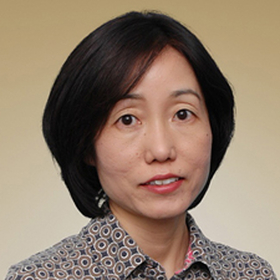

Saeko
Takada
Research interests
Living organisms employ a variety of DNA damage responses to prevent permanent genomic damage. Divergent health problems, including cancer, neurodegenerative disorders, immune deficiencies, and infertility could arise from a failure of DNA damage response. DNA damage responses are indispensable in various tissues at different life stages, including during development. In evolutionally conserved DNA damage singling pathways, DNA lesions such as double-strand breaks recruit sensors and mediators that initiate DNA damage signaling, including MRN (Mre11/Rad50/Nbs1) complex and protein kinases such as ATM (Ataxia-Telangiectasia Mutated) and ATR (ATM and Rad3-related) to the damage sites. These kinases phosphorylate a second subset of protein kinases called effector kinases that include Chk1 and Chk2. The activated effector kinase targets and phosphorylates a wide range of downstream proteins that are directly involved in different cellular processes such as cell cycle control, DNA repair, transcription, regulation of cytoskeleton, and mitosis. My laboratory studies how the effector kinase targets divergent substrates in the cell and how it impacts specific cellular processes.
We currently focus on studying mechanisms of embryonic DNA damage responses. We use a Drosophila model system for our research, since this system allows us to utilize genetics, high quality in vivo imaging, and biochemical approaches to study DNA damage responses in the context of development. In early Drosophila embryos, DNA damage disrupts mitosis. It also inhibits normal nuclear positioning, cell-cycle remodeling, activation of zygotic transcription, and cellularization. A conserved tumor suppressor Chk2 is essential for these embryonic DNA damage responses. In somatic cells, Chk2 is known to affect cellular functions including cell cycle checkpoints, apoptosis, DNA repair, RNA processing, and transcription, after DNA damage. Taking full advantage of the Drosophila model system, we have uncovered remarkably dynamic behavior of Chk2 throughout the cell cycle in early embryos. Chk2 mobility and dynamic behavior appear to play important roles to efficiently target the kinase to its substrates throughout the cell. We investigate relationship between Chk2 localization/dynamics and its functions, by combining genetics, confocal imaging, and in vivo analyses of mutant protein functions. In addition, we aim to identify Chk2 binding partner(s) and/or target(s) at the cellular structures where Chk2 localizes, using proteomic approaches. We anticipate understanding molecular mechanisms of the embryonic DNA damage responses that link genome integrity to control of mitosis and developmental progression. Our study should provide us with a paradigm and tools to investigate whether similar DNA damage responses operate in mammals.
Selected publications
Takada S, Collins ER, Kurahashi K. The FHA domain determines Drosophila Chk2/Mnk localization to key mitotic structures and is essential for early embryonic DNA damage responses. Mol Biol Cell. 2015; 15;26(10):1811-28. PMID: 25808488; PMCID: PMC4436828. [PubMed]
Awata J, Takada S, Standley C, Lechtreck KF, Bellvé KD, Pazour GJ, Fogarty KE, Witman GB. NPHP4 controls ciliary trafficking of membrane proteins and large soluble proteins at the transition zone. J Cell Sci. 2014; 1;127(Pt 21):4714-27. PMID: 25150219; PMCID: PMC4215714. [PubMed]
Takada S, Cha BJ. In vivo live-analysis of cell cycle checkpoints in Drosophila early embryos. Methods Mol Biol. 2011;782:75-92.
PubMed PMID: 21870286. [PubMed]
Lovly CM, Yan L, Ryan CE, Takada S, Piwnica-Worms H. Regulation of Chk2 ubiquitination and signaling through autophosphorylation of serine 379. Mol Cell Biol. 2008; 28(19):5874-85. PMID: 18644861; PMCID: PMC2547006. [PubMed]
Takada S, Kwak S, Koppetsch BS, Theurkauf WE. grp (chk1) replication-checkpoint mutations and DNA damage trigger a Chk2-dependent block at the Drosophila midblastula transition. Development. 2007;134(9):1737-44. PMID: 17409117. [PubMed]
Oikemus SR, McGinnis N, Queiroz-Machado J, Tukachinsky H, Takada S, Sunkel CE, Brodsky MH. Drosophila atm/telomere fusion is required for telomeric localization of HP1 and telomere position effect. Genes Dev. 2004; 1;18(15):1850-61. PMID: 15256487; PMCID: PMC517405. [PubMed]
Takada S, Kelkar A, Theurkauf WE. Drosophila checkpoint kinase 2 couples centrosome function and spindle assembly to genomic integrity. Cell. 2003; 113(1):87-99. PMID: 12679037. [PubMed]
Casey DM, Inaba K, Pazour GJ, Takada S, Wakabayashi K, Wilkerson CG, Kamiya R, Witman GB. DC3, the 21-kDa subunit of the outer dynein arm-docking complex (ODA-DC), is a novel EF-hand protein important for assembly of both the outer arm and the ODA-DC. Mol Biol Cell. 2003 Sep;14(9):3650-63. PMID: 12972554; PMCID: PMC196557. [PubMed]
Takada S, Wilkerson CG, Wakabayashi K, Kamiya R, Witman GB. The outer dynein arm-docking complex: composition and characterization of a subunit (oda1) necessary for outer arm assembly. Mol Biol Cell. 2002;13(3):1015-29. PMID: 11907279; PMCID: PMC99616. [PubMed]
Wakabayashi K, Takada S, Witman GB, and Kamiya R. (2001). Transport and arrangement of the outer-dynein- arm docking complex in the flagella of Chlamydomonas mutants that lack outer dynein arms. Cell Motility and the Cytoskeleton 48:277-86. PubMed PMID: 11276076
Masuda H, Takada S, Shibata T, Cande WZ, Hiraoka Y. (2001). In vitro approaches for the study of microtubule nucleation at the fission yeast spindle pole body. Methods Cell Biol. 67:167-77. PubMed PMID: 11550467.
Takada S, Shibata T, Hiraoka Y and Masuda H. (2000). Identification of ribonucleotide reductase protein R1 as an activator of microtubule nucleation in Xenopus egg mitotic extracts. Molecular Biology of the Cell 11:4173- 4187. PMCID: PMC15065